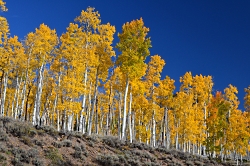
Image courtesy USDA Forest Service
J Zapell, Photographer
But consider the words of a philosophy generally attributed to the Native American Iroquois Confederacy dated around 1500 AD: That decisions we make regarding resources today should result in a sustainable world seven generations into the future. If you prefer, you can consider how the modern United Nations describes sustainable development which is: “Development that meets the needs of the present without compromising the ability of future generations to meet their own needs.”
Here is a short list of 12 things you can do to help protect our resources for the future:
-
1. Conserve energy inside your home in winter by turning down the heat and dressing warmer indoors. In summer, close the window blinds facing direct sunlight. (Utah Clean Energy)
2. Walk wherever possible for good health and saving fuels. ()
3. Last year Americans used 50 billion plastic water bottles. Fill reusable water bottles at home and take it with you. Most of the bottled water today is filtered tap water. (Mathematics for Sustainability: Fall 2017)
4. Turn off the lights in unoccupied rooms. That means in your homes, schools, churches and work places. (When to Turn Off Your Lights (US Dept of Energy))
5. Try using things more than once. Padded envelopes are just one example. (US EPA: Reduce, Reuse, Recycle)
6. Reduce landfill waste. The average American uses 350 bags each year. Instead of plastic or paper, use strong canvas or cloth bags which can be reused for many years. (15 Easy Ways To Reduce Landfill Waste)
7. Contact the companies that send junk mail to your home and discontinue those mailings. Or you’ll have extra papers to recycle…with your name and address on them. (National Do Not Mail List)
8. If your community doesn’t recycle, find local retailers who will take used oil, batteries, ink cartridges, and light bulbs. Don’t throw them into the trash. (Logan City Recycling)
9. Plant trees wherever you can. They help wildlife, help purify the air, protect the soil, and provide shade in hot summer months. (Everyone Can Plant a Tree and Help Fight Climate Change (Arbor Day Foundation))
10. Plant nectar gardens for our declining species of butterflies and bees. Their health and success directly affects our food supplies. (5 Spring Plants That Could Save Monarch Butterflies)
11. Never throw waste products into our streams, rivers, lakes or oceans. (Utah Clean Water Partnership)
12. Learn how to compost your food waste into usable soils for the future. (USU Extension Hosting)
This is Ron Hellstern, and I am Wild About Utah.
Credits:
Images: Courtesy USDA Forest Service J Zapell, Photographer
Audio: Contains audio Courtesy & Copyright Friend Weller, Utah Public Radio
Text: Ron Hellstern, Cache Valley Wildlife Association
Included Links: Lyle Bingham, Webmaster, WildAboutUtah.org
Additional Reading
6 Ways You Can Help Keep Our Water Clean (Natural Resources Defense Council)
30 Practical Ways To Cut Fuel And Energy Use And Allow The Natural Environment To Grow Again
The Sweet Song Of The Largest Tree On Earth, Science Friday, National Public Radio, May 12, 2023, https://www.sciencefriday.com/segments/listen-to-the-pando-largest-tree/
